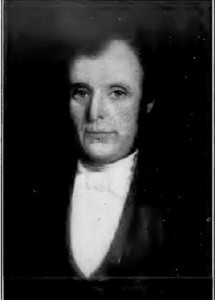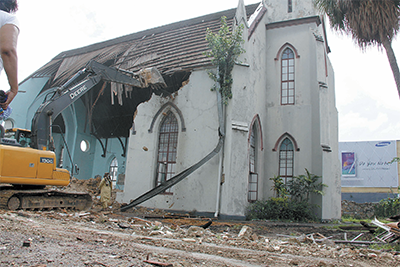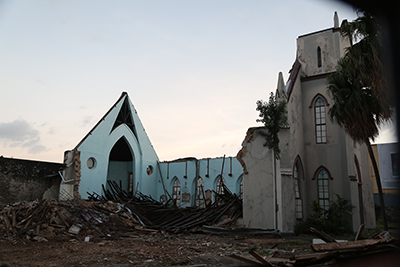It was very early, before dawn one Sunday morning in November 2014, that an excavator belonging to Joel Ramdeen and Co, rolled unto the hallowed and historic site of the Greyfriars Church of Scotland. In decades gone by, hymns and prayers emanating upwards to God would have been heard at this time. Instead this morning under the cover of darkness, the north wall of this church came crashing down.
Proverbs 22:28
28 Remove not the ancient landmark, which thy fathers have set.
 The church’s first minister was Rev. Alexander Kennedy of Greyfriars Secession Church, Glasgow, Scotland. He arrived in Trinidad on 25 January, 1836 to begin a mission to preach the gospel to the newly emancipated Africans. Initially worship was held in a building located at Cambridge Street (formerly, the section of present day St. Vincent Street from Park Street to Oxford Street). The construction of the Greyfriars Church commenced on 10 April, 1837, with the first service being held on 10 January, 1838. It then officially opened under the historic name of Greyfriars on 25 January, 1838.
The church’s first minister was Rev. Alexander Kennedy of Greyfriars Secession Church, Glasgow, Scotland. He arrived in Trinidad on 25 January, 1836 to begin a mission to preach the gospel to the newly emancipated Africans. Initially worship was held in a building located at Cambridge Street (formerly, the section of present day St. Vincent Street from Park Street to Oxford Street). The construction of the Greyfriars Church commenced on 10 April, 1837, with the first service being held on 10 January, 1838. It then officially opened under the historic name of Greyfriars on 25 January, 1838.
Apart from just being a church, it also was the location of a small graveyard. The graves of at least three children are on the compound, which is located near Woodford Square, the Red House, Public Library building and Trinity Cathedral.
In the church were also the memorial tablets commemorating the work of Rev. Kennedy and Rev. Brodie, as well as congregationers who fell during the two World Wars. It is not certain what has become of these tablets and the other historical artifacts. The church was the subject of a painting by Trinidad and Tobago’s famed artist, Michel-Jean Cazabon, in 1870.
Amos 1:3
3 Thus saith the LORD; For three transgressions of Damascus, and for four, I will not turn away the punishment thereof; because they have threshed Gilead with threshing instruments of iron:

The Greyfriars Church of Scotland, was identified as a heritage property on the National Inventory of Cultural and Natural Heritage as a historical site. It is also one of the sites which was in the process of being listed by law. Once listed, in accordance with Section 8 of the National Trust Act (No. 11 of 1991 and Amendment No. 31 of 1999) the property would have been deemed a heritage property and would have been entitled to legal protection.
However the plans to preserve this national treasure were thwarted when it was sold to a private developer.
According to the National Trust: “Prior to its sale the National Trust through its member and technical advisor, the Historical Restoration Unit, Ministry of Works and Infrastructure, advised the Town and Country Planning Division as to how this property should be managed as one of our built heritage monuments, in keeping with conservation guidelines. The building is on the Trust inventory and is soon to be listed by law.The National Trust of Trinidad and Tobago is established by law (Act 11 of 1991, amended by 31 of 1999), to oversee the preservation of our built and natural heritage. The major responsibilities of the Trust include the following:-
– Listing and acquiring such heritage property as the Trust deems appropriate;
– Permanently preserving lands that are heritage sites and as far as practicable retaining their natural features and conserving the animal and plant life;
– Preserving, maintaining, repairing and servicing or, arranging for the preservation of heritage property and where such property comprises buildings, augmenting the amenities of such buildings and their surroundings;
– Making provision for the access to and enjoyment of heritage property by the public;
– Encouraging research into heritage property;
– Making the public aware of the importance of our heritage;
– Advising Government on the care of our heritage

The developer, not wanting to lose the opportunity to cash in on this prime piece of real estate, hurried demolition work, with no demolition approvals granted by the Port-of-Spain City Corporation. Standing in the rain as he surveyed the scene in disbelief, then Minister of National Diversity and Social Integration Rodger Samuel said: “They just don’t have respect for this country—absolutely no respect—because we have been negotiating, the Town and Country Division up to Thursday was negotiating with this gentleman in good faith trying to help him work around it. And this is what happens, like a thief in the night.”
In order to get some positive public relations going concerning the ruin of this piece of history, in January 2016, the owner of the now completely emptied property has allowed Laventille steelband Witco Desperadoes to use the site as their panyard. I suppose so that they can dance and trample upon the graves of those who preached the gospel and may have dedicated their lives to serving the LORD.